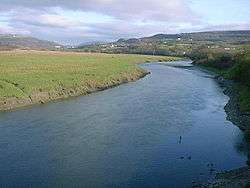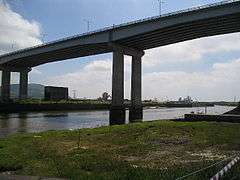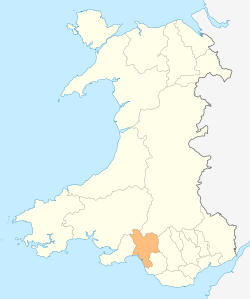River Neath
River Neath (Welsh: Afon Nedd) is a river in south Wales running south west from its source in the Brecon Beacons National Park to its mouth at Baglan Bay below Briton Ferry on the east side of Swansea Bay.
| River Neath | |
|---|---|
 The river at Neath Castle, looking upstream. | |
| Native name | Afon Nedd |
| Location | |
| Country | United Kingdom, Wales |
| Region | South Wales |
| County | Neath Port Talbot |
| Cities | Pontneddfechan, Glyn-neath, Resolven, Neath |
| Physical characteristics | |
| Source | |
| ⁃ location | Pontneddfechan, Powys, Wales |
| Length | 30.6 km (19.0 mi) |
| Discharge | |
| ⁃ location | Baglan Bay |
| Basin features | |
| Tributaries | |
| ⁃ left | Melincourt Brook, Clydach Brook |
| ⁃ right | River Dulais, River Clydach |
Several minor rivers rise on the southern slopes of Fforest Fawr. These include the Afon Hepste, Afon Sychryd, Afon Pyrddin, Nedd Fechan and Afon Mellte, the latter two converging at Pontneddfechan to form the River Neath. Upstream from these confluences is the area known as Waterfall Country (Welsh: Coed y Rhaeadr), where the rivers plunge over a series of spectacular cataracts.
The river flows through the Vale of Neath, a long straight valley developed along the Neath Disturbance and which carried a major glacier during the ice ages. Downstream of Pontneddfechan the river has few significant tributaries. Those that do join include the Melincwrt Brook and the Clydach Brook. The only major tributary to join is the River Dulais which has its source north of Seven Sisters. As the Dulais nears the Neath it descends a spectacular waterfall: the Dulais Falls, a popular tourist attraction owned and managed by the National Trust and the site of old iron workings. Close by the river flows past the once grand estate of Ynysygerwn. A smaller tributary, the River Clydach, flows southward through the village of Bryncoch to join the Neath at Neath Abbey.
The River Neath provides water to two canals, the Neath Canal and the Tennant Canal. At Aberdulais basin, both canals meet, the Tennant Canal crossing the River Neath with a fine aqueduct. Also crossing the river here is the Vale of Neath Railway line and the A465 road. As it approaches the town of Neath the river passes the ancient church of Saint Illtud at Llantwit. Further on it loops around the former workhouse at Llety Nedd and skirts Penydre. Here it passes close to the Norman castle, visited by King Henry II, King John and King Edward I.
As it meanders around the town of Neath it passes the remains of the Roman fort Nidum at Court Herbert and the Cistercian monastic foundation of Neath Abbey. Its monks used their access to the river to challenge the trading rights of the burgesses of the town of Neath.
The estuary of the River Neath extends from Neath town down past Briton Ferry to the sea next to Jersey Marine Beach. The estuary is partly industrialised with a ship breaking yard, a large local authority waste disposal site and wharves at Melincryddan, Briton Ferry and Neath Abbey. Where it remains undisturbed, there are areas of salt marsh stretching from Neath to Baglan Bay and Crymlyn Burrows which are of great ecological value.
Gallery
 Sgwd Gwladus waterfall in the headwaters of the River Neath
Sgwd Gwladus waterfall in the headwaters of the River Neath M4 over River Neath
M4 over River Neath

